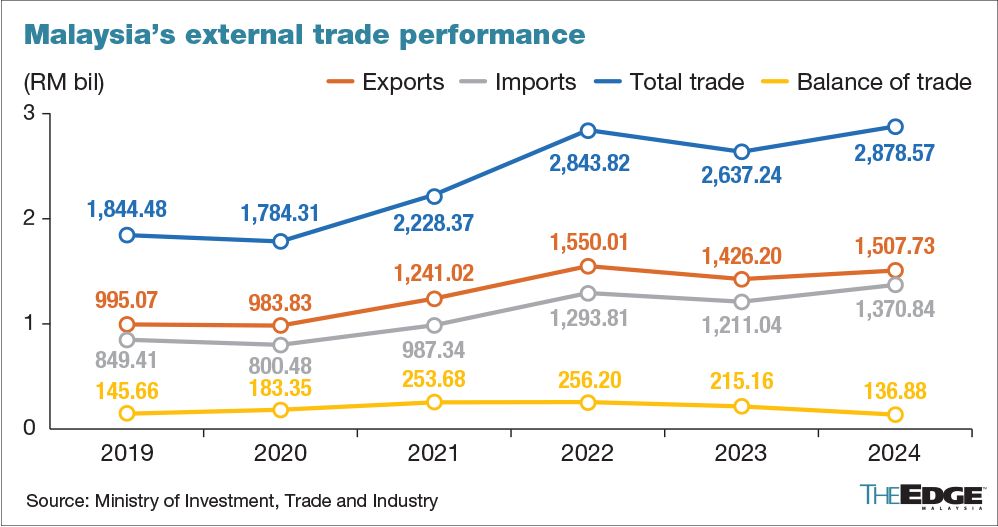_theedgemalaysia_theedgemalaysia.jpg&w=1920&q=75)
KUALA LUMPUR (Jan 20): Malaysia’s exports continued their expansionary trajectory in 2024, driven by strong performances in both manufactured and agricultural products, official data on Monday showed.
Exports rose 5.7% to RM1.508 trillion in 2024 from 2023, surpassing the RM1 trillion mark for the fourth consecutive year, according to the Ministry of Investment, Trade and Industry (Miti) in a statement, driven by increases in exports to Asean, the US, EU and Taiwan — with exports to the US and Taiwan reaching an all-time high.
At the same time, imports jumped 13.2% to RM1.371 trillion — the third consecutive year the tally crossed RM1 trillion.
The growth in exports and imports drove Malaysia's total trade for 2024 up 9.2% to a new record high of RM2.879 trillion. This also marks the fourth consecutive year that the country's total trade comes in above RM2 trillion.
"This exceptional performance has resulted in a trade surplus of RM136.88 billion," said Miti, noting it is the 25th consecutive year of surplus since 1998.
E&E exports hit record RM601.18b
The 2024 export achievement accounted for 87.2% of the target set for 2025 under the Mid-Term Review of the 12th Malaysia Plan, Miti noted.
The growth in exports was primarily driven by increased shipments of electrical and electronic (E&E) products, which accounted for 39.9% of total exports. E&E exports rose by 4.5% to RM601.18 billion, marking the highest value ever recorded for the sector.
Palm oil and palm oil-based agricultural products, as well as manufactures of metal and rubber products, also contributed to the expansion.
Exports to China — Malaysia’s largest trading partner for the 16th consecutive year since 2009 — dipped 2.2% to RM187.67 billion on weaker demand for E&E products and metalliferous ores and metal scrap. The impact of this contraction was mitigated by robust exports of paper and pulp products, rubber products, and optical and scientific equipment.
In contrast, exports to the US — Malaysia’s third-largest trading partner since 2015 — rose 23.2% to a record high of RM198.65 billion, driven by strong demand for E&E products, machinery, equipment and parts, and rubber products.
Exports to free-trade-agreement markets expanded in 2024, reversing the contraction experienced in 2023, Miti noted.
"Canada was one of those export destinations which recorded growth, driven by higher demand for E&E products, while exports to Türkiye and Mexico soared to a new record high, fuelled by the increased shipments of iron and steel products as well as chemicals and chemical products, respectively.
"Diversification strategies targeting emerging markets have also played an equally important role in contributing to export growth, particularly to countries such as Bangladesh, Costa Rica, Egypt, Nigeria, Angola, Ethiopia, Algeria, Togo, Libya and notably Kenya, Oman and Namibia which rose to a new record level," Miti added.

